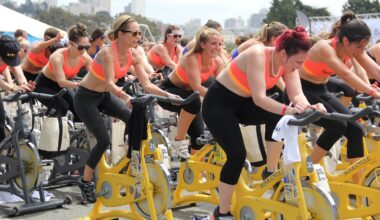Posture Correction Tips for Seniors: Staying Active and Upright
Maintaining good posture is crucial for seniors, as it promotes better balance and helps prevent falls. One way to improve posture is through regular stretching exercises. Incorporating specific stretches targeting the neck, back, and shoulders can alleviate stiffness and improve flexibility. It is recommended to perform stretches twice daily. Additionally, seniors should focus on strength training exercises that reinforce core muscles and back stability. These exercises enhance overall body strength and promote a straight posture. Activities like yoga or tai chi are fantastic for improving posture, as they emphasize body awareness and alignment. Ensure to consult with a doctor before beginning any exercise regimen to tailor it to your abilities. Furthermore, using assistance devices like canes or walkers can help maintain balance and proper alignment while moving. Incorporate short exercise sessions throughout the day to avoid prolonged sitting, which is detrimental to posture. Staying active is key, so complete simple walking programs as part of your daily routine. Overall, the combination of strength, flexibility, and balance exercises will significantly improve your posture and enhance your daily life.
Benefits of Good Posture for Seniors
Good posture offers numerous benefits to seniors, contributing positively to their overall health and well-being. Maintaining an upright position can significantly reduce chronic pain, particularly in the back and neck areas. Proper alignment alleviates pressure on the spine and joints, thus minimizing discomfort. Additionally, enhanced posture improves lung capacity, promoting easier breathing and better oxygen flow to the body. With improved breathing efficiency, seniors can feel more energetic, allowing them to engage in daily activities without unnecessary fatigue. Furthermore, good posture boosts confidence, as standing tall contributes to a more positive self-image. This can encourage greater social interaction and prevent feelings of isolation. In addition, focusing on posture while walking or performing activities fosters greater awareness of body mechanics, which can prevent falls and injuries. Practicing good posture during everyday activities like sitting, standing, and walking can create long-term habits that benefit physical health. Ultimately, the benefits of good posture extend beyond physical appearance, influencing psychological aspects that encourage seniors to lead active, fulfilling lifestyles. Regular practice is essential to make any improvements permanent and effective.
To effectively correct posture, seniors should be aware of their body alignment while performing daily tasks. Utilize mirrors to monitor your posture while standing or sitting. When seated, ensure your feet are flat on the ground and your back is straight. Adjust your chair to achieve this alignment. Furthermore, employing supportive chairs can significantly enhance posture during sitting. Make sure to choose a chair that promotes an upright position with adequate lumbar support. When using devices such as computers or tablets, position screens at eye level to avoid slouching. Practicing mindful movements, such as standing up straight when getting out of a chair, can establish a consistent posture routine. Additionally, seniors can invest in posture-correcting devices, such as braces, that provide guidance and support. These tools serve as reminders to maintain proper positioning throughout the day. However, consider using them as temporary solutions rather than replacements for regular exercises. Encouraging family and friends to participate in posture improvement activities can make the process more enjoyable and effective. Such shared experiences foster healthier habits and ensure everyone stays active together in their journey toward better posture.
Integrating Posture Improvement into Daily Routines
Incorporating posture improvement strategies into seniors’ daily routines can yield significant benefits in overall mobility and health. Start each day with a few minutes dedicated to gentle stretching to loosen tight muscles. Focus on areas commonly affected by poor posture, such as the upper back, shoulders, and hip flexors. Consider integrating balance and core-strengthening exercises during your routine. Simple exercises like leg raises, squats, and wall sits can strengthen support muscles. Consider joining a community class or group dedicated to senior fitness. Engaging in group classes allows seniors to follow guided sessions specifically tailored to their needs. It also creates a social atmosphere. While at home, pay attention to posture during daily activities like cooking or cleaning. Set reminders to check your alignment while working in the garden or tidying up. Establishing fun challenges with friends and family around posture improvement can motivate everyone involved. Make a conscious effort to stand tall whenever conversing or walking, reinforcing good habits. These daily integrations collectively enhance joint stability, allowing seniors to remain more active, confident, and upright throughout their day.
Several exercises can be tailored specifically for seniors to support posture improvement. Start with simple neck stretches by tilting the head gently from side to side, holding each position for 15 to 20 seconds. Shoulder rolls are effective in reducing tension and enhancing mobility. Perform these by raising the shoulders toward the ears and rolling them backward and downwards. Incorporating back extensions may also be beneficial. Seniors can do this by lying on their stomachs and gently lifting their upper body off the ground. Core-strengthening exercises, such as sitting up straight while engaging abdominal muscles while seated, can offer ongoing support. Gentle yoga poses, like the cat-cow stretch, can also promote spinal flexibility. Be mindful of maintaining proper alignment throughout these exercises to gain the maximum benefit. Engaging in gentle swimming or aquatic exercises can minimize impact while improving muscle strength and flexibility. Every exercise should be done with care and attention to form. Consulting with a fitness professional experienced with seniors can aid in developing a safe and effective exercise regimen suitable for specific needs. Overall, consistency is essential for achieving lasting changes.
Seeking Professional Guidance
For seniors looking to significantly improve posture, working with a qualified physical therapist may be very beneficial. A professional can assess individual posture and provide tailored exercises to enhance alignment. Personal trainers with experience in senior fitness can also guide proper movements and ensure safety during workouts. They offer personalized attention that can prevent injuries while promoting effective posture correction. Before beginning any program, ensure to communicate any medical conditions or limitations to the therapist or trainer. This information allows the professional to develop an effective and customized plan. Regular sessions can help seniors develop strength and flexibility over time with consistent feedback. Additionally, therapists can help seniors establish realistic goals while monitoring progress along the way. If facing challenges with specific exercises, a therapist can provide alternative movements to fit different abilities while still addressing posture-related issues. Follow-up sessions encourage accountability and continuity in your practice. Lastly, it is vital to build a supportive network, as encouragement from professionals, friends, and family members can have a major positive impact. Celebrate small achievements as these milestones collectively contribute to a more active and upright lifestyle.
Finally, staying motivated is key in any posture improvement journey for seniors. Setting realistic, achievable goals can keep individuals focused. Start with small steps, such as incorporating a daily stretching routine. Gradually add other posture-enhancing exercises as confidence grows. Tracking progress through journals or apps can provide visual reminders of achievements, enhancing motivation. Celebrate accomplishments, no matter how small, as this fosters a positive mindset towards ongoing practice. Joining community groups or participating in classes geared specifically toward seniors can create a support system while sharing similar challenges. Engaging in friendly competitions with peers can mark milestones to motivate continuous improvement. Encouraging family members to join can make activities more enjoyable and help maintain each other’s motivation. Regularly remind yourself about the benefits of improved posture, such as increased energy and overall physical stability. This positive reinforcement encourages them to stay committed to their goals. As with any fitness initiative, patience is essential, and gradual improvements will lead to more significant changes. Embrace this journey towards better posture and overall health, ensuring every step leads to a happier, healthier life.
In conclusion, improving posture is an essential aspect of maintaining an active lifestyle for seniors. By incorporating targeted exercises, consulting professionals, and cultivating a supportive environment, seniors can make meaningful strides in correcting posture. Engaging mindfully in daily routines, celebrating progress, and remaining committed to the process are crucial for achieving lasting results. Every effort counts, and as fitness and flexibility increase, these improvements empower seniors to remain active and upright. Together, these strategies create a pathway toward better health, confidence, and fulfillment in ultimately enhancing quality of life.


